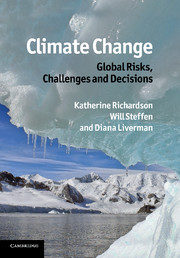Book contents
- Frontmatter
- Contents
- Writing team
- Foreword
- Preface
- List of acronyms and abbreviations
- Part I Climatic trends
- Part II Defining ‘dangerous climate change’
- Part III Equity issues
- Part IV Mitigation and adaptation approaches
- 11 Low-carbon energy technologies as mitigation approaches
- 12 Economic approaches and instruments
- 13 Geopolitics and governance
- 14 Adapting to the unavoidable
- Part V Meeting the challenge
- Index
- Plate section
- References
11 - Low-carbon energy technologies as mitigation approaches
Published online by Cambridge University Press: 04 April 2011
- Frontmatter
- Contents
- Writing team
- Foreword
- Preface
- List of acronyms and abbreviations
- Part I Climatic trends
- Part II Defining ‘dangerous climate change’
- Part III Equity issues
- Part IV Mitigation and adaptation approaches
- 11 Low-carbon energy technologies as mitigation approaches
- 12 Economic approaches and instruments
- 13 Geopolitics and governance
- 14 Adapting to the unavoidable
- Part V Meeting the challenge
- Index
- Plate section
- References
Summary
‘The only engine big enough to impact Mother Nature is Father Greed: the Market. Only a market, shaped by regulations and incentives to stimulate massive innovation in clean, emission-free power sources can make a dent in global warming.’
Introduction
The joint climate and development imperatives described in the previous chapters demand a strong, immediate and sustained response. As outlined in Chapter 8, the global community has approximately four decades to implement a reduction in greenhouse gas emissions in the order of 90%.
The transition to a low-carbon/low-emissions economy will likely take many forms and be played out on local, national and regional levels as well as on the global stage (Chapter 13). While little has so far been done to initiate this transition, a diverse suite of existing and near-term technologies exist that can be components of regionally tailored low-carbon energy mixes, and which can underpin an aggressive expansion of energy efficiency worldwide. The challenge is, in effect, one of inventing and implementing a new energy economy in around four decades; i.e. in a fraction of the time it took to build the entire current industrial energy infrastructure.
A new ‘triple bottom line’ is therefore needed: one that is low-carbon, high-growth and job-creating. To further increase this challenge, this must be achieved in not only a few small segments of the global population, but also widely across industrialised and developing nations – from household and village scales, to national and regional economies.
- Type
- Chapter
- Information
- Climate Change: Global Risks, Challenges and Decisions , pp. 281 - 316Publisher: Cambridge University PressPrint publication year: 2011



